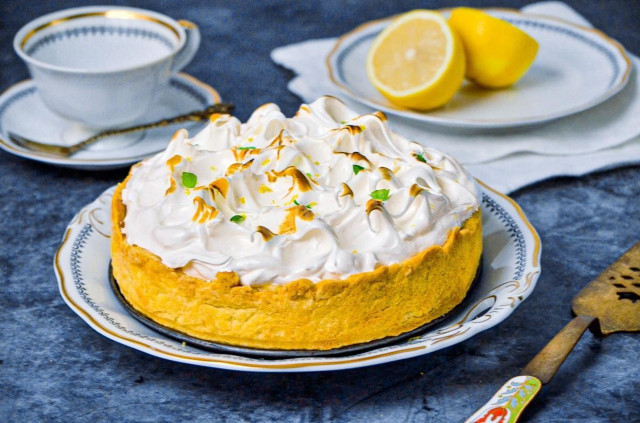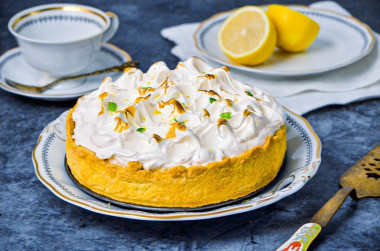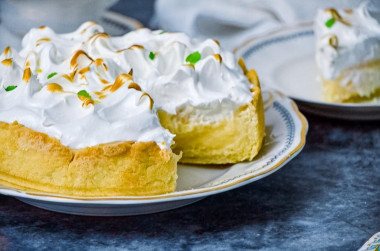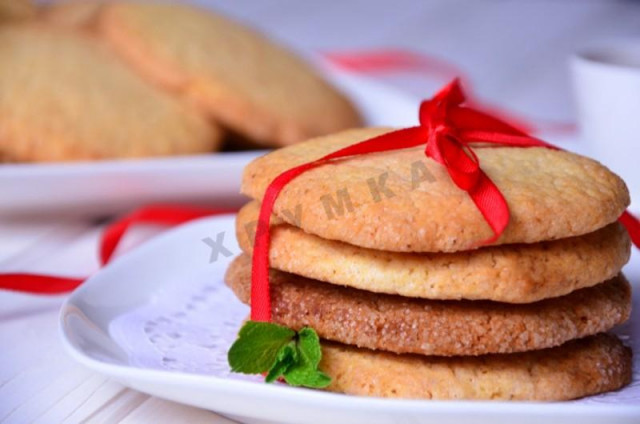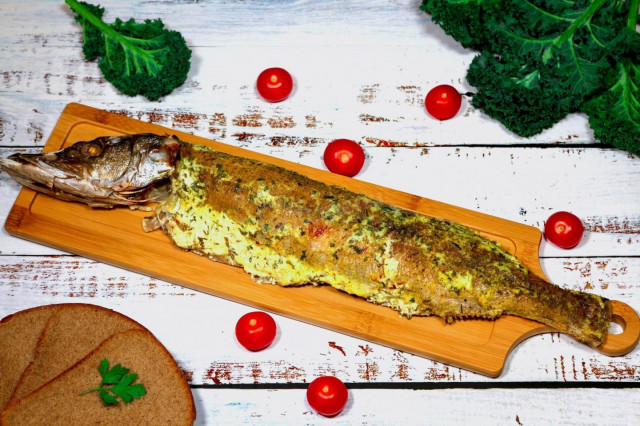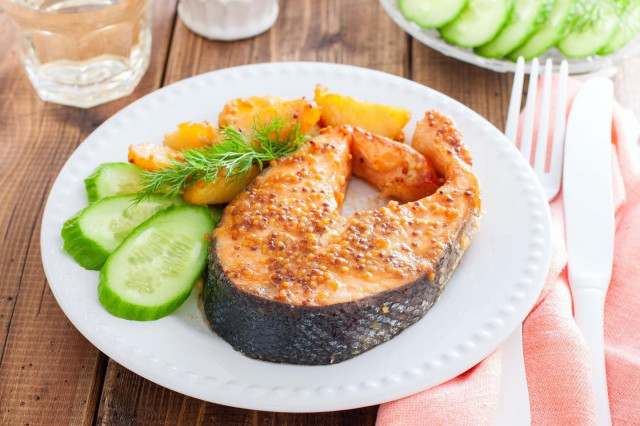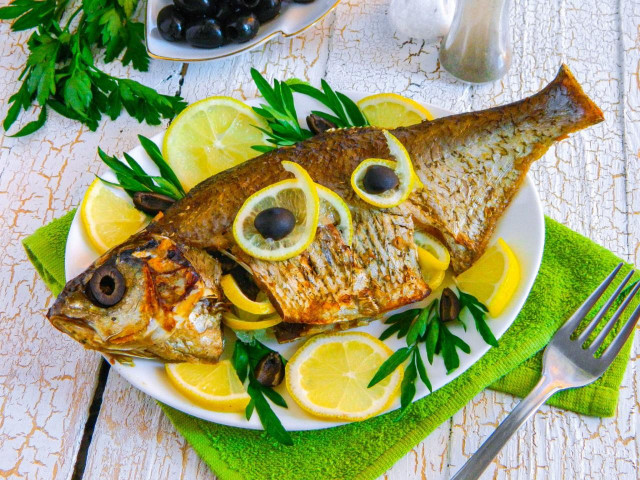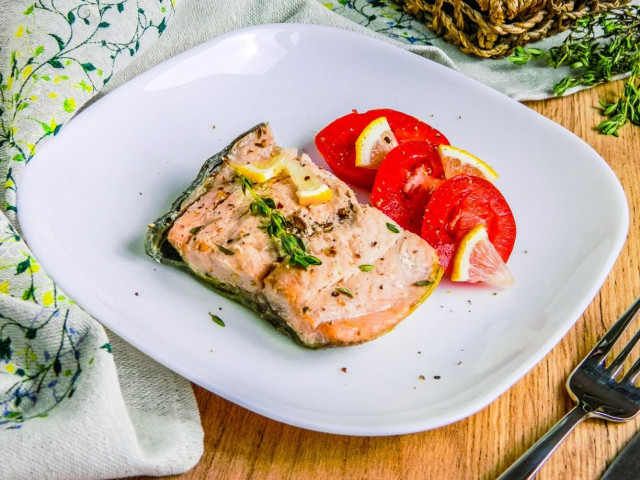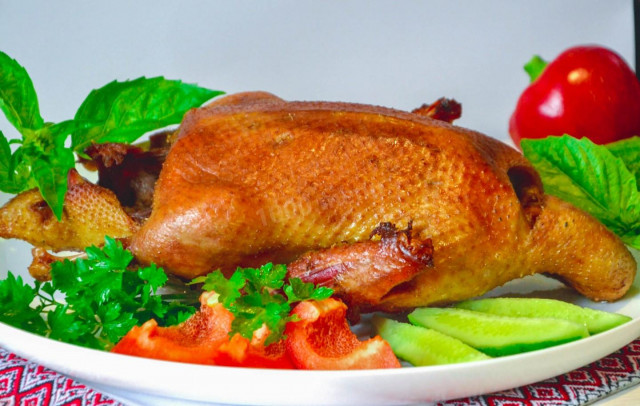Composition / ingredients
Step-by-step cooking
Step 1:
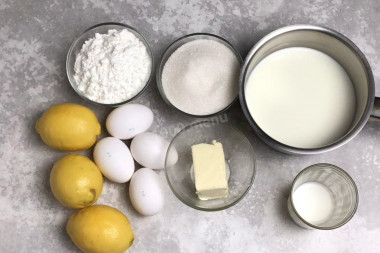
How to make lemon tart with meringue? Start cooking with lemon cream. Prepare the products for him. I have corn starch. If you have potato, take it twice as much. You will need two servings of milk - 350 ml and 50 ml.
Step 2:
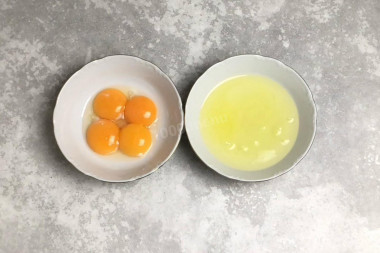
Wash and dry the eggs with napkins. Then divide the whites and yolks into separate bowls. For the cream, we will need only the yolks. Put the squirrels aside - we'll need them later.
Step 3:
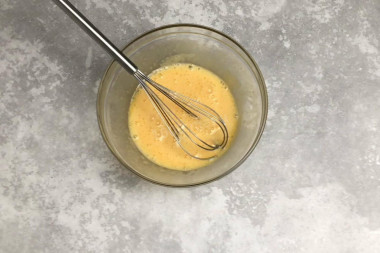
Beat the raw yolks in any way, you can with a mixer, you can with a whisk. Add 50 ml of milk to them and whisk again.
Step 4:
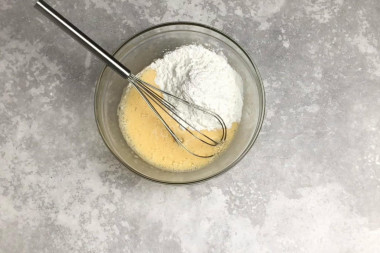
Add starch to the yolks, mix the mass with a whisk so that there are no lumps in it.
Step 5:
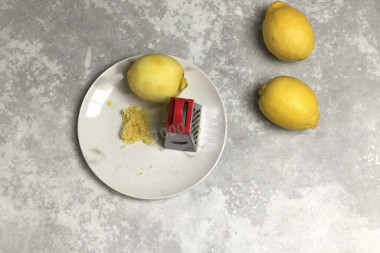
Wash and dry the lemons. Remove the zest from them with a fine grater.
Step 6:
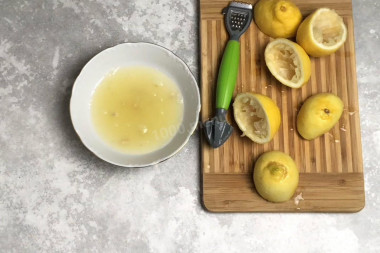
Squeeze the juice out of all the lemons. Then strain the juice through a sieve, separating the pulp and bones.
Step 7:
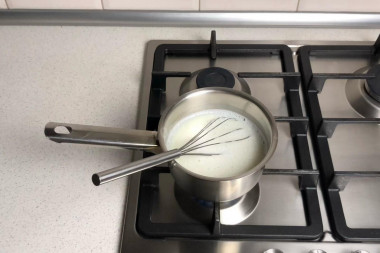
Pour 350 ml of milk into a saucepan. Add sugar to the milk and put the pan on the fire. Cook until boiling, stirring with a whisk. The sugar should completely dissolve.
Step 8:
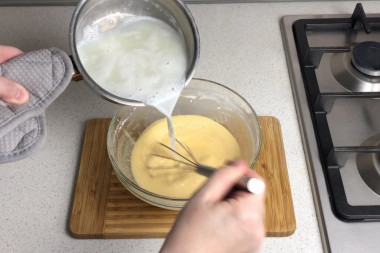
Pour hot milk in a thin stream into the beaten yolks while stirring continuously.
Step 9:
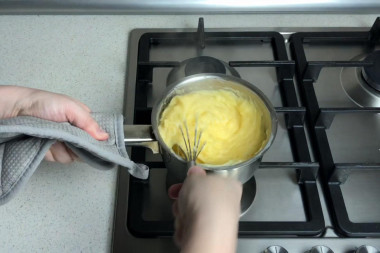
Return the pan of milk to the fire. Cook until thickened. It is necessary to stir the cream with a whisk all the time so that it does not burn from below and does not go in lumps. Put a small fire. When the cream becomes quite thick, remove it from the heat.
Step 10:
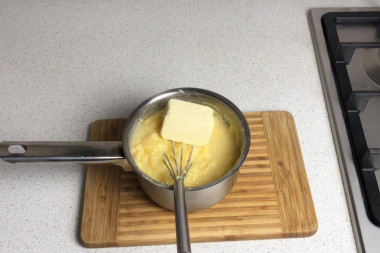
Add grated zest, lemon juice and butter to the yolk cream. Stir thoroughly. Leave to cool.
Step 11:
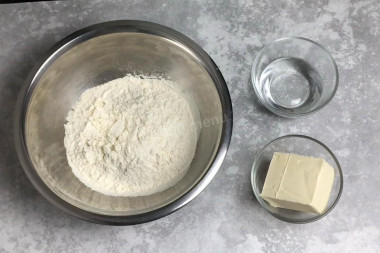
While the cream is cooling, prepare a sand base. Put the oil in the freezer beforehand. The water should also be icy. Sift the flour and add a pinch of salt to it.
Step 12:
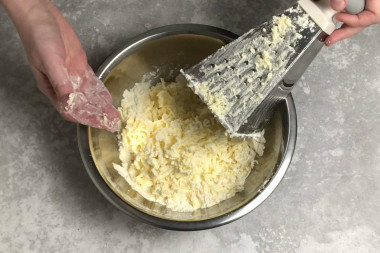
Grate the cooled butter directly into the sifted flour. It will be more convenient to do this by dipping the butter in flour - so it will not slip in your hands.
Step 13:
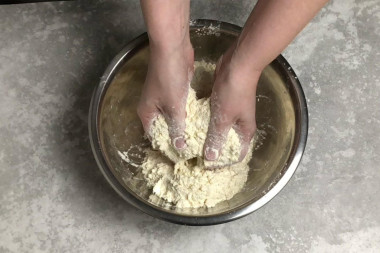
Rub the butter with flour with your hands until a sand crumb forms. It is necessary to work quickly so that the oil does not start to melt. Then add water to the crumbs and knead the shortbread dough. Do not knead the dough too much, you just need to assemble it into a ball.
Step 14:
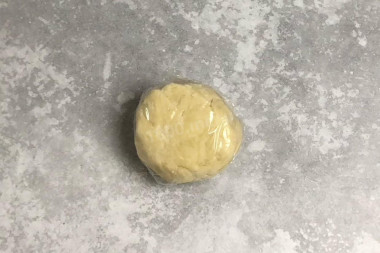
Wrap the dough ball in plastic wrap and put it in the refrigerator for half an hour.
Step 15:
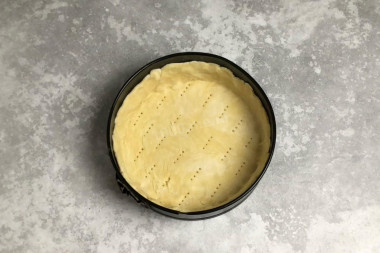
Roll out the rested dough into a round layer about 5 mm thick. Put it in a baking dish, form the sides - you should get such a basket of dough. Prick it with a fork in several places. Why prick the dough with a fork? When baking, it will not swell and will not bubble. It is not necessary to lubricate the mold.
Step 16:
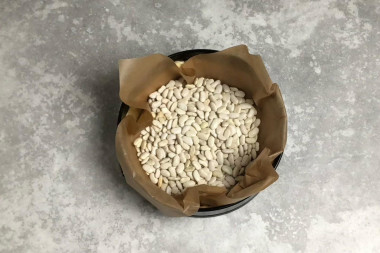
Place baking paper on top of the dough basket. Pour a load, for example, raw hard beans or peas. This will also prevent the base from bloating when baking.
Step 17:
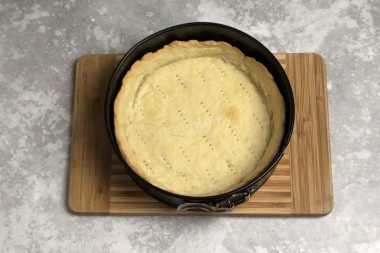
Bake the base of the pie at a temperature of about 200 degrees for about 15 minutes with a load. Then remove the paper with the beans and bake for another 10 minutes at the same temperature until lightly browned. Allow the base to cool completely. Determine the exact time and temperature of baking according to your oven.
Step 18:
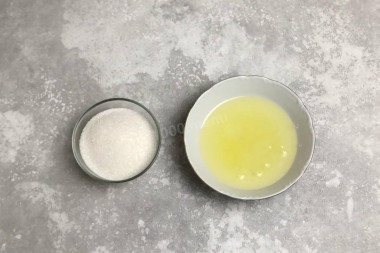
Now start cooking the meringue.
Step 19:
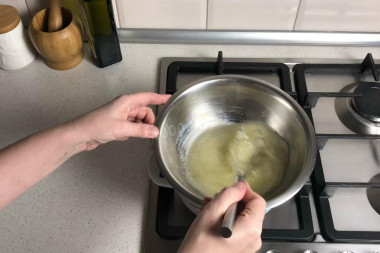
Build a water bath on the stove. To do this, boil some water in a saucepan and put a bowl on top. The bottom should not touch the water. Pour the proteins into a bowl and add sugar. Stir the sugar until it is completely dissolved.
Step 20:
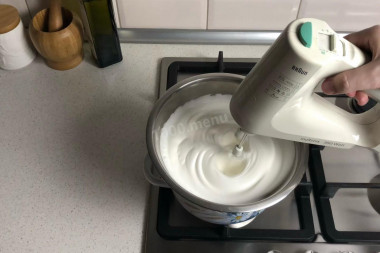
Then start whipping the whites with a mixer right in the water bath. Beat for about 5 minutes, until a fluffy white mass.
Step 21:
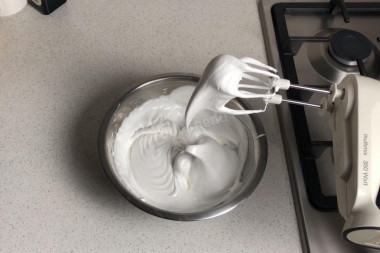
Then you need to quickly cool the proteins. To do this, transfer the bowl with them to a basin with water, to which ice is added. This will stop the brewing of proteins. Continue whipping the whites for a couple more minutes. The goal is to achieve hard peaks.
Step 22:
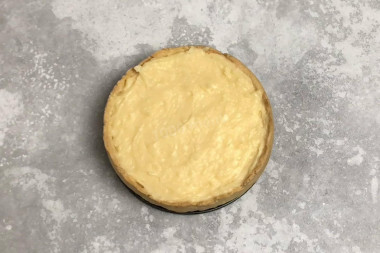
Put the cream on a sand base, gently smooth it out.
Step 23:
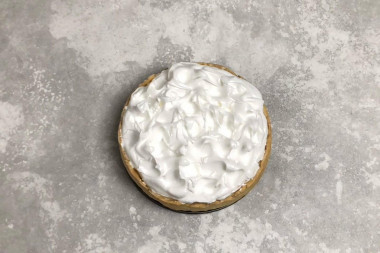
Put the protein meringue on top. This can be done with a pastry bag, depositing the whipped whites in the form of roses. Or you can just use a spoon, making a chaotic pattern.
Step 24:
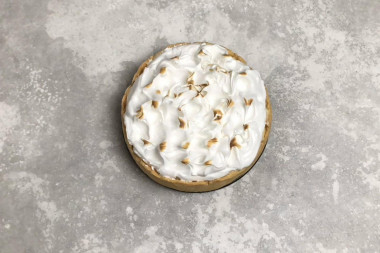
Burn the top of the protein peaks with a pastry burner. Or you can put the pie in the oven under the grill for a couple of minutes. Serve the tart on the table, having previously cooled it well. Bon appetit!
This consumption of products is designed for tart with a size of about 22-24 cm.
Be prepared for the fact that flour may need more or less than indicated in the recipe. Focus not on the amount of flour, but on the desired consistency of the dough. To avoid mistakes, read about flour and its properties!
Keep in mind that everyone's ovens are different. The temperature and cooking time may differ from those specified in the recipe. To make any baked dish successful, use useful information about the features of ovens !
Caloric content of the products possible in the composition of the dish
- Whole cow's milk - 68 kcal/100g
- Milk 3.5% fat content - 64 kcal/100g
- Milk 3.2% fat content - 60 kcal/100g
- Milk 1.5% fat content - 47 kcal/100g
- Concentrated milk 7.5% fat content - 140 kcal/100g
- Milk 2.5% fat content - 54 kcal/100g
- Lemon - 16 kcal/100g
- Lemon zest - 47 kcal/100g
- Whole durum wheat flour fortified - 333 kcal/100g
- Whole durum wheat flour universal - 364 kcal/100g
- Flour krupchatka - 348 kcal/100g
- Flour - 325 kcal/100g
- Granulated sugar - 398 kcal/100g
- Sugar - 398 kcal/100g
- Butter 82% - 734 kcal/100g
- Amateur unsalted butter - 709 kcal/100g
- Unsalted peasant butter - 661 kcal/100g
- Peasant salted butter - 652 kcal/100g
- Melted butter - 869 kcal/100g
- Salt - 0 kcal/100g
- Water - 0 kcal/100g
- Egg yolks - 352 kcal/100g
- Egg whites - 44 kcal/100g
- Corn starch - 329 kcal/100g

